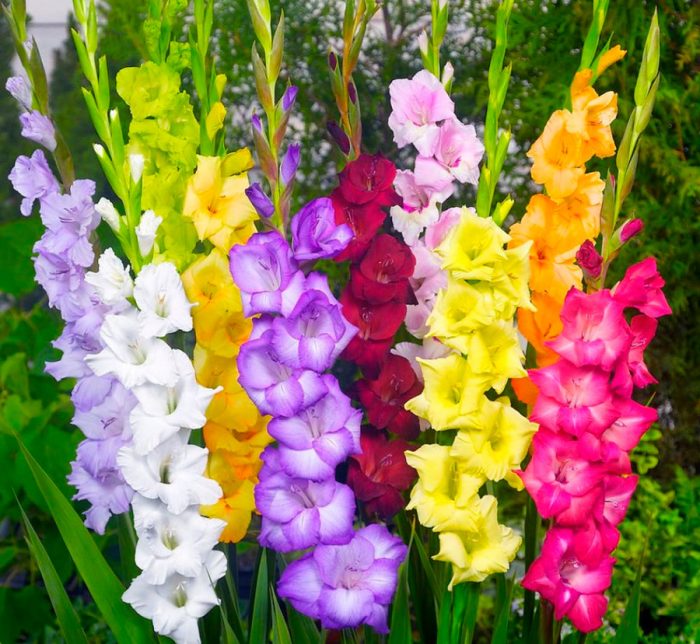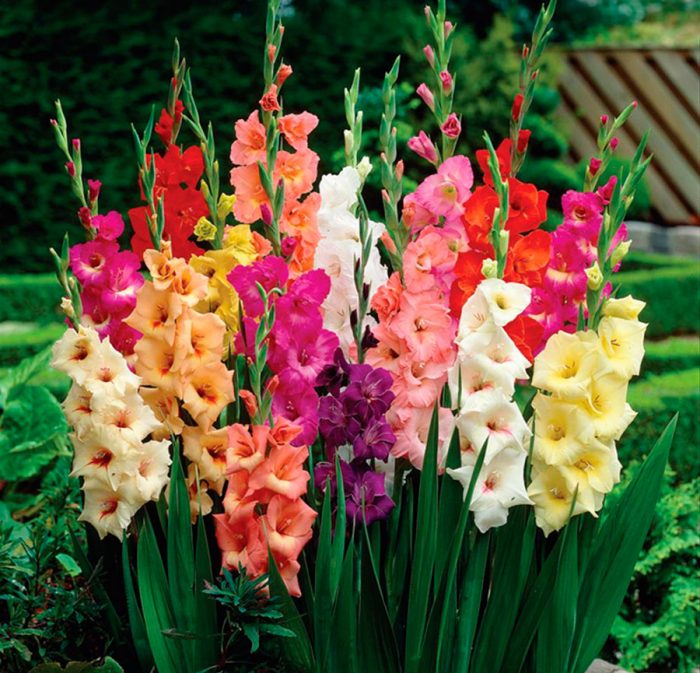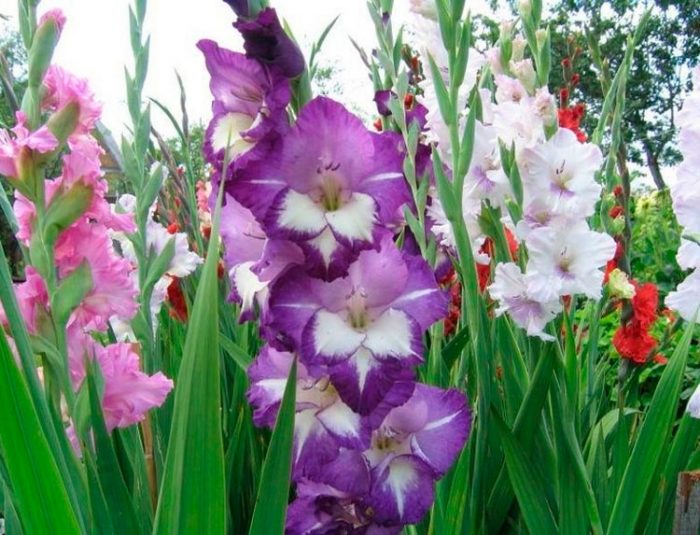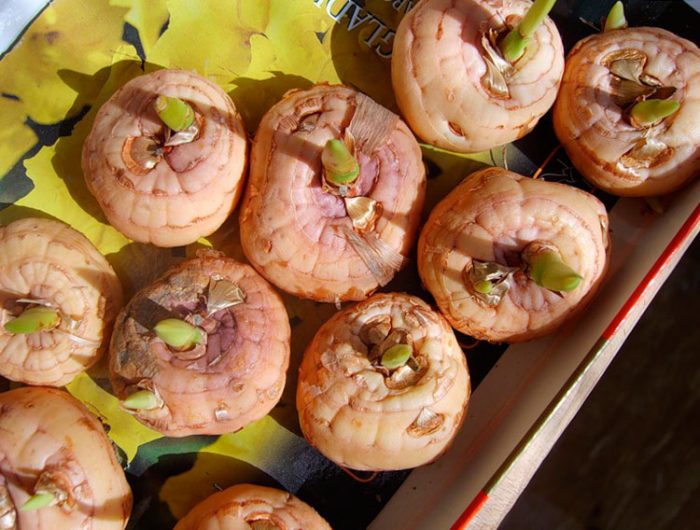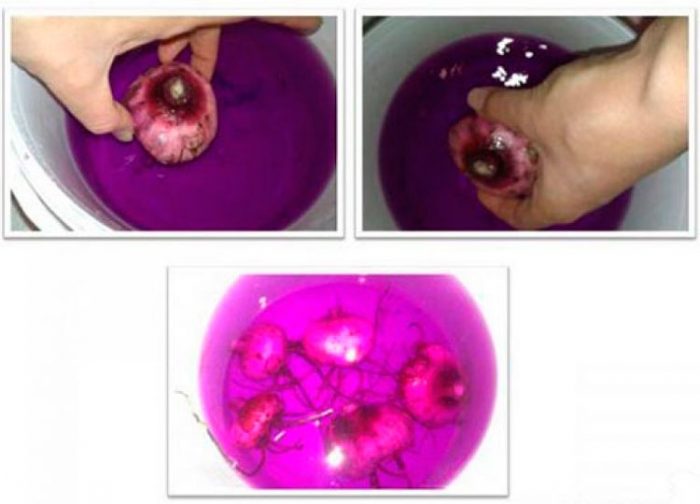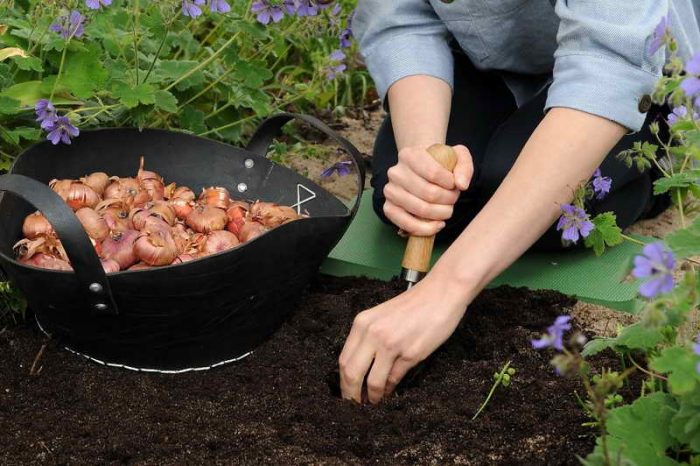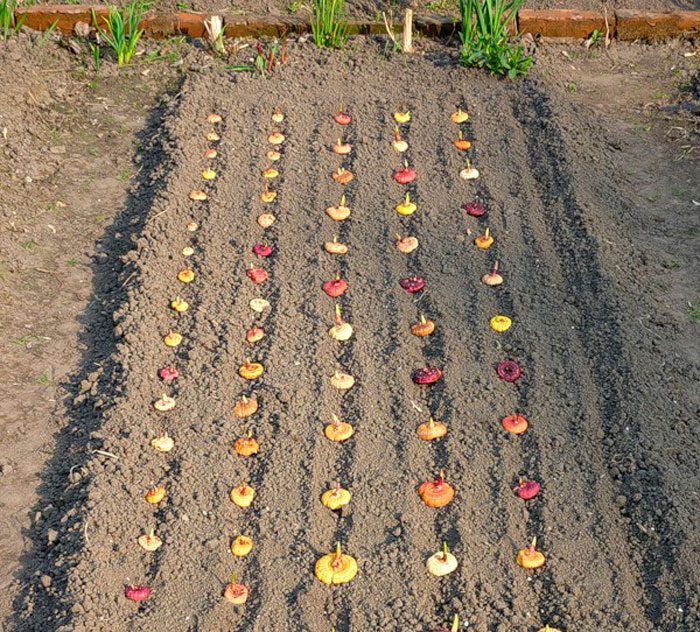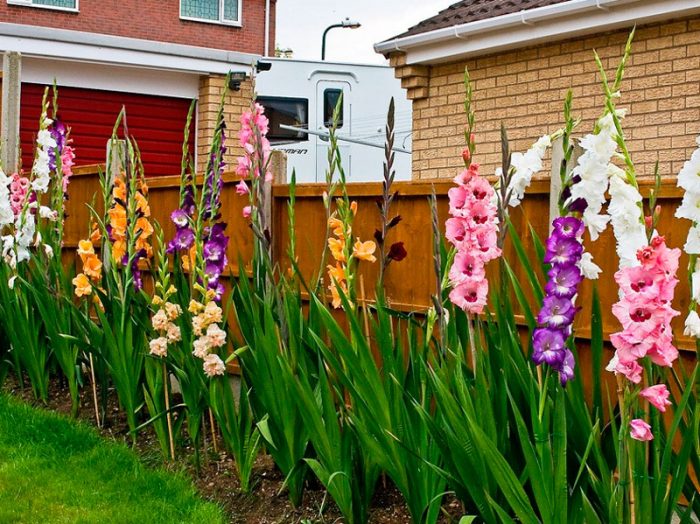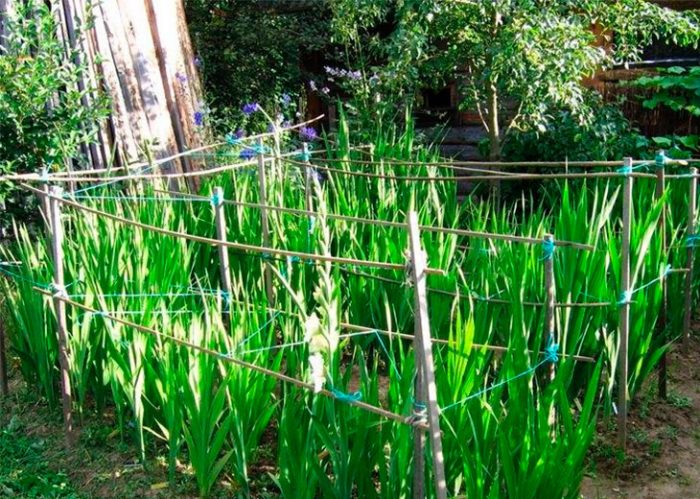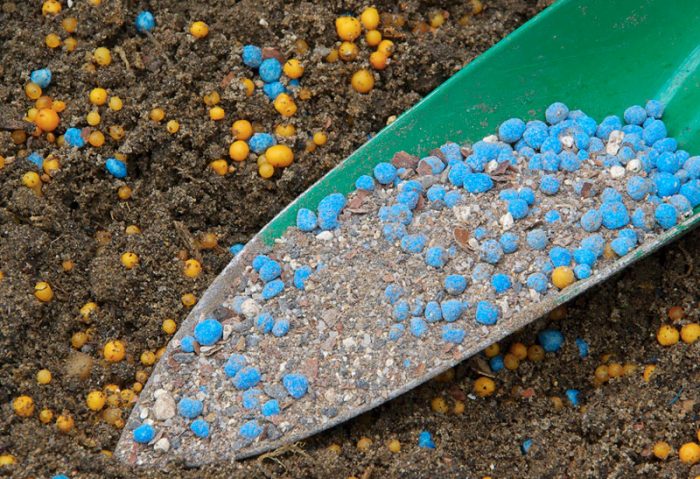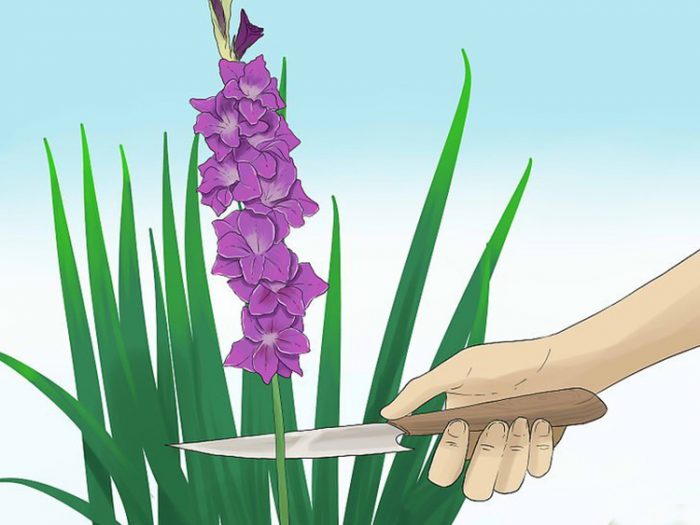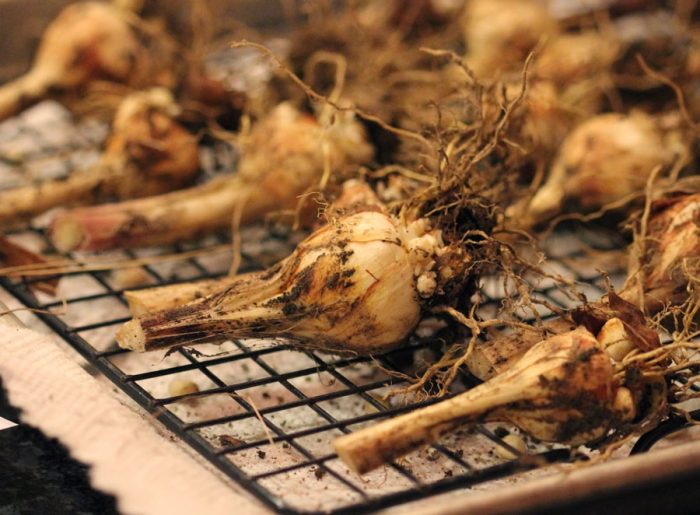The flowering plant gladiolus (Gladiolus), also called the skewer, has been cultivated by gardeners for a long time and with great pleasure. However, in ancient Greece 300 years BC, such a plant was considered a weed of wheat fields. But in ancient Rome, gladioli began to be used to decorate patrician gardens. Today, every year such a plant is becoming more and more popular.
Content
Brief description of cultivation
- Bloom... From the first weeks of summer (early varieties) to early autumn.
- Landing... In the springtime.
- Digging out the bulbs... From early to mid-autumn.
- Storage... In a cool place (5 to 10 degrees).
- Illumination... Needs bright sunlight.
- Priming... Sandy loam, structural black soil or light loam. The soil should be slightly acidic (pH 6.5 to 6.8).
- Watering... Watering on average 1 time in 7 days is very abundant (for 1 square meter of land from 10 to 12 liters of water).
- Fertilizer... They use liquid mineral fertilizers and organic matter. Top dressing on foliage is carried out at the beginning of the growing season and during the formation of buds, and the root one: the first - during the formation of 1 or 2 true leaf plates, the second - during the development of 5 or 6 leaf plates, the third - before the buds begin to form.
- Reproduction... Seed and vegetative (corms and buds).
- Harmful insects... Thrips, meadow mites, cabbage scoops, wireworms, bears, slugs.
- Diseases... Fusarium, gray rot, sclerotiniasis, septoria, bacterial scab, cancer, penicillosis, curvularia, smut, viral diseases.
Basic rules for growing
Before you start growing gladiolus in your garden, you need to familiarize yourself with the 11 most important rules that will help you grow healthy plants with beautiful flowers:
- It is impossible to grow such flowers in the same place for more than 2 years. In the third year, a different place is chosen for their planting.
- During the transplant of gladioli, you need to try to choose a site whose soil composition will differ from the previous one. For example, if flowers were grown in light black soil, then they can be planted in sandy loam soil.
- Purchase the planting material that has been adapted to the climatic conditions of your region. This is due to the fact that these flowers react extremely negatively if they get from a warm climate into a damp and cool one.When purchasing planting material from Holland, remember that such gladioli will bloom magnificently and very effectively, but only once.
- Large bulbs should not be planted near children, as they will oppress them. It is recommended to plant in order: from small to large bulbs. Experienced gardeners recommend choosing the largest corms and planting them separately.
- Planting the corms at the correct depth is very important. In heavy soils, the bulb is planted to a depth equal to 3 of its diameters, and in light soils - four. If the bulb is buried very deeply in the soil, then this can cause the lack of flowering. And if it is deepened to an insufficient depth, then an arrow garter may be needed.
- When 3-5 days remain before the daughter bulbs are planted in open soil, they will need to remove dense scales, otherwise the sprouts may not appear. When they are planted, they are watered once every 2 days.
- This is a light-loving plant. If the late variety is grown in a shaded place, then you can not wait for its flowering at all. However, early varieties, if desired, can be grown in a shady or semi-shaded place, but in this case the bushes will bloom much later.
- The area where flowers grow must be ventilated, otherwise the bushes can infect fungal diseases.
- If the flowers are grown in sandy loam, then they must be fed regularly on foliage.
- In the summer, the bushes should be watered about 1 time in 7 days, but at the same time abundantly enough. During a prolonged dry period, they are watered daily in the evening, after which the surface of the soil is loosened, bushes are huddled and weeds are pulled out.
- Dig up the corms and store them correctly, and you should pay special attention to this.
Planting gladiolus bulbs outdoors
Preparing the bulbs for planting
When 20-30 days remain before planting gladiolus bulbs in the ground, you should start preparing them. To do this, dense covering scales are carefully removed from them, trying not to injure delicate sprouts. But first, the planting material is sorted out, removing all partially diseased or diseased corms. If they are not sick with scab or sclerotinia, then they can be left, but at the same time it is necessary to carefully cut out the affected area, and the sections will need to be processed with brilliant green. Prepared bulbs must be placed in a well-lit and warm place, for this they are laid out in 1 layer with sprouts up, since they will have to grow well.
Before planting the bulbs on a flower bed, they are treated in order to prevent fungal diseases and thrips, for this they use a solution of potassium permanganate (0.3%), in which they are kept for 1 to 2 hours, instead, they can be immersed in Fundazol solution for 1 hour (0.3%). If, after processing, gladioli are immediately planted, then they can be for 30 minutes. immerse in a solution of potassium manganese (0.5 grams per liter of water), the pulled out bulbs are planted in the holes (no need to wash).
Children also need preparation before boarding. When 1.5–2 weeks remain before planting in the ground, those buds are chosen that reach 0.7–0.8 cm in diameter (in medium-sized varieties, you can take smaller children), while each of them should have a distinct root tubercles are visible. It is necessary to remove the hard shell from them. After that, the children are laid out in cardboard boxes in 1 layer, which are placed in a well-lit place, but the light should be diffused. After they grow, they are placed in a solution of potassium manganese for 9 hours (1 gram per liter of water).
Landing rules
The site for growing such a flower is chosen especially carefully, while taking into account all its features. This culture is warm and light-loving, therefore, the chosen planting site must necessarily meet these requirements.It is best to choose a sunny area with well-drained soil that has reliable protection from drafts. The cooler the climate in the region, the more light such flowers need, and if the site is even slightly shaded, this will have an extremely negative effect on the flowering and growth of the bushes. Areas where groundwater is very close to the soil surface are not suitable for growing gladioli. When cultivated in more southern regions, slightly shading of the site is allowed at noon. The surface of the soil can be perfectly flat or have a slight slope of 5 degrees to the south, which will allow excess liquid to drain.
Pay special attention to the acidity of the soil, as it is very important when cultivating such a plant. It grows best on slightly acidic soil (pH 5.6 to 5.8). If the soil is more acidic, then at the leaf plates of the plant, the tips will become dark and begin to dry out, while the opening of flowers will slow down, and the bush itself can infect fusarium. In alkaline soil, the iron contained in it does not dissolve, and therefore it is not absorbed by the gladiolus root system, which slows down the production of chlorophyll in the foliage of the flower, as a result of which its yellowing begins. To fix acidic soil, dolomite flour, chalk or egg shells should be added to it during digging at the rate of 150 to 200 grams per 1 square meter of the site.
Such a culture grows very well on soil that has the same structure as that of structural chernozem, and it also develops well on sandy loam or on light loam. In order to fix heavy loam, sand should be added to it for digging, and on the contrary, clay is introduced into the sandy soil along with rotted manure and humus.
A well-warming area is digged right before planting gladioli. If, however, prolonged droughts are often observed in the region, then in order to retain more water in the soil, the main digging is carried out in the autumn, while in the spring, before planting gladioli, the surface of the site is slightly loosened. The best predecessors of such flowers are legumes and vegetables, as well as perennial herbs. And the area where asters and root crops were grown is the least suitable for planting such a flower.
The ridge should be about 100–120 cm wide. If already in autumn you have decided on the area where gladioli will grow next year, then it is recommended to add dry potash to the soil (for 1 square meter of the area from 30 to 40 grams of potassium chloride ) and phosphoric (100 grams of superphosphate per 1 square meter of the plot) fertilizers, after which they dig. Before digging the site in the spring, it is recommended to apply chlorine-free potash fertilizers, for example, potassium magnesium or potassium sulfate, to the soil. In spring, digging is not carried out as deep as in autumn (about 10 centimeters less). The bulbs are planted in open ground from the last days of April until the second half of May, but remember that you need to make adjustments for the weather and climate.
When planting, corms are buried to the following depth: small - from 8 to 10 centimeters, and large - from 10 to 15 centimeters. In this case, the distance between small onions should be from 7 to 8 centimeters, and between large ones - about 15 centimeters. The row spacing is from 20 to 25 centimeters. The prepared planting groove is spilled with Fitosporin solution or clean water, then a layer of sphagnum is placed on the bottom or a layer of river sand about 20 mm thick is poured. Only after that, the bulbs are laid out in it, which are then buried. Sphagnum is able to prevent rot and retain water in the soil, so that it will not dry out even on hot days.
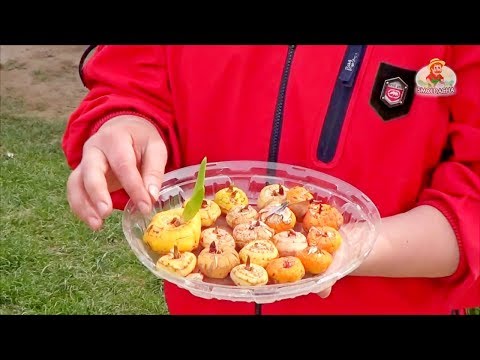

Watch this video on YouTube
Gladiolus care
In order for gladiolus to grow normally and bloom magnificently, it needs good care.After the sprouts that have appeared on the flowerbed reach a height of about 10 centimeters, the surface of the soil is covered with a layer of mulch (humus), while its thickness should be about 50 mm. It is able to protect the soil from overheating and drying out, and during watering, the bulbs will receive additional nutrition.
Watering
On average, watering is carried out 1 time in 7 days in the early morning or in the evening, while 10 to 12 liters of water are taken per 1 square meter of the plot. Before watering, between the rows, it is recommended to make furrows with a depth of 30 to 50 mm, into which water is poured, in this case, liquid droplets cannot get onto the surface of the foliage. After watering, the soil around the bushes is loosened to a depth of 50 to 60 mm, which will prevent the appearance of a crust on its surface. After that, the bushes must be spud. The soil should be loosened at least 1 time per decade, no matter how many times it rained during this time. In a hot dry period, the frequency of watering is increased to 1 time in three or four days, if this is not done, then the peduncle will be lethargic, and the flowers in the upper part will dry out even before opening.
Garter
After the buds form on the arrows, you need to tie them to the pegs (if necessary), also remember that you need to promptly cut off the flowers that have begun to fade, in this case the bush will not waste its energy on the formation and ripening of seeds.
Weeding
The area where gladioli grow must be weeded in time. As a rule, flowers are weeded 3 or 4 times in 1 season. Pay special attention to the cleanliness of the site during the emergence of sprouts, since if they are drowned out by weeds, then the bushes may not bloom later. And also remember that a large amount of weed on the site is often the cause of the appearance of pests or the defeat of gladioli by various diseases.
Fertilizer
At different stages of growth, such flowers are fed with various mineral fertilizers. During the formation of the first 2 or 3 true leaf plates, fertilizing is carried out with nitrogenous fertilizer, namely, 25–35 grams of ammonium nitrate, or 25 grams of ammonium sulfate, or 25 grams of urea per 1 square meter of the site are applied to the soil. If the bushes feel a lack of nitrogen, this will lead to the fact that the color of the foliage will become faded. However, if there is too much nitrogen in the soil, then because of this, the greens will grow very actively at the expense of flowering, while the bushes will become more susceptible to fungal diseases. The second time the gladioli should be fed with potassium-nitrogen-phosphorus fertilizer, this is done after the formation of 5 or 6 leaf plates, for this, 10–20 grams of ammonium sulfate, 15–20 grams of superphosphate and 10–20 grams of potassium sulfate based on 1 square meter of plot. For the third time, phosphate-potassium fertilizer is used, while feeding is carried out before the formation of buds, as soon as the peduncle appears, for this, 15–20 grams of potassium chloride and 30–40 grams of superphosphate per 1 square meter of land should be added to the ground.
Such flowers also need organic matter, which should be introduced into the soil in liquid form, since in this case the nutrients will go directly to the root system of the bushes. At the very beginning of growth, if desired, the bushes can be fed with infusion of bird droppings, for its preparation you need to combine 40-50 liters of water with 30 liters of droppings, the mixture is infused for 10-12 days. The finished infusion is diluted with water (1:10) and grooves made in advance between the rows are poured into it, then the surface of the soil is loosened, and the bushes are spud.
The bushes should be fed with mineral fertilizers every 15–20 days, but with the onset of mid-August, all fertilizing is stopped. Horse manure cannot be used to fertilize this crop. However, it reacts well to feeding on foliage using a solution of minerals, thanks to which the bushes will bloom earlier, and this will also have a beneficial effect on their decorative effect.For this, a solution of copper sulfate (0.2 grams per liter of water), boric acid (0.15 grams per liter of water) or manganese potassium (0.15%) is perfect. During the season, you can carry out 2 or 3 foliar dressings, as a rule, this is done at the beginning of growth and during the formation of buds, while before spraying, the solution must be mixed with a small amount of soap and try to get the mixture on both surfaces of the leaf plates.
Cutting flowers
It is imperative to cut the flowers correctly. Cutting is carried out with a very sharp knife in the evening or early morning. In this case, after cutting, the remainder of the peduncle should be deep between the remaining leaf plates, of which at least 4 pieces should remain on the bush, this will allow the bulb to continue to grow and develop normally.


Watch this video on YouTube
Cleaning and storage of corms
What time to dig up the bulbs
It is necessary to dig up the bulbs of gladioli in the autumn, when after flowering it will take from 35 to 45 days. The bulbs ready for digging have integumentary root scales, while their babies are also covered with dense scales, and they themselves effortlessly detach from the mother corm. To dig up gladioli, you should choose a day when the weather will be dry. The early varieties are dug up first, and then the later ones. In the last place, they dig the plantings of children and small bulbs. In the event that signs of damage to corms with brown or black spot were found, then they will need to be dug out early, thanks to this, it will be possible to avoid their damage by other diseases. To make it easier to dig gladioli, they can be mowed beforehand, however, if desired, the stems with foliage can be cut with pruning shears already from the bulbs dug out. The roots are also cut off. After that, the remains of the soil are carefully shaken off from the corms, and then the children are separated. After that, they are put in special boxes with a mesh or fine-mesh bottom, each variety separately, then they are thoroughly washed under running water. Then they must be disinfected by immersing for this for 20–30 minutes. into a solution of Fundazole (1%), then they are taken out and washed again in clean running water. Then they are treated with a solution of potassium manganese (3%) and laid out to dry for two or three days. Dried onions are folded into boxes, the bottom of which is lined with paper sheets, and stored in a warm place (from 25 to 30 degrees), and do not forget to turn them over systematically. After 1.5-2 weeks, they are removed to a cooler place (from 18 to 22 degrees). And after another 1-1.5 months, the corms can be peeled and sorted. The dirty uppermost scales are removed from them, and the children are also separated.
How to properly prepare babies for storage? First, they should be sorted by size and grade. Large babies reach 8 mm or more in diameter, and medium ones - from 6 mm. After that, they are folded into paper bags and stored at a temperature of no more than 5-6 degrees. If they are stored in a warmer place, then there is a high probability that they will not rise in the spring. If there is no other place, then you can store them on the refrigerator shelf.


Watch this video on YouTube
Basic rules for storing bulbs
The duration of the natural resting period in gladioli is about 35–40 days, at this time no shoots will appear on the bulbs, no matter what conditions they are in. However, when this period ends, the likelihood of the appearance of sprouts increases, but this cannot be allowed, since it is still very far to land in the ground. In order to preserve gladioli until the onset of the warm season, they are stored for storage in a cool room (no more than 5-10 degrees), while the humidity level there should be from 60 to 70 percent.In order for the bulbs to be better preserved, several peeled garlic cloves must be put in the box where they are located, while at least once every 4 weeks the planting material is examined, removing the spoiled bulbs, and at the same time the garlic is replaced. A ventilated cellar or a cold basement is considered the best storage room for such flowers, while it is recommended to put them in boxes with a mesh bottom, since the bulbs can breathe normally in them. Drawers can be arranged on a rack, this is not only convenient, but also saves usable space. Also, for storing planting material, you can use bags, for the manufacture of which you can take oversized tights.
If you have to store gladioli in the refrigerator, then choose the lower shelf for vegetables, and they should be placed in hermetically sealed containers to prevent dehydration during storage. However, each of the onions is pre-wrapped in a paper sheet. At the end of winter, corms begin to "breathe", while moisture is released, so at this time they are taken out and unfold, and when they are completely dry, they are wrapped again in fresh paper sheets and put into the refrigerator, but in a colder place.
In regions with a mild climate and warm winters, bulbs are stored in winter on an insulated balcony or loggia, while they are pre-placed in boxes or boxes, which are made on a stand of boards. If a cold snap is expected, then the bulbs are covered with an old fur coat or blanket. In extreme cases, gladioli can also be stored in room conditions, while they are laid out in 1 layer so that the bulbs do not come into contact with each other. By the spring they will dry out, therefore, before planting, it is recommended to keep them in a solution of a drug that stimulates growth for some time. And if such bushes are well looked after, then they will grow and bloom within normal limits.
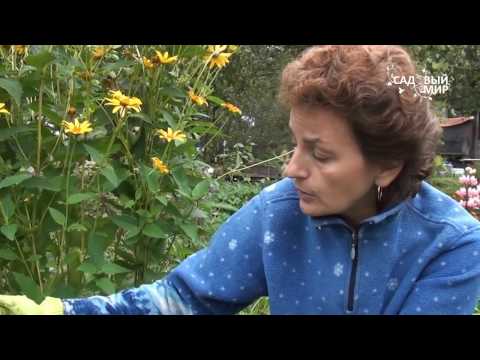

Watch this video on YouTube

